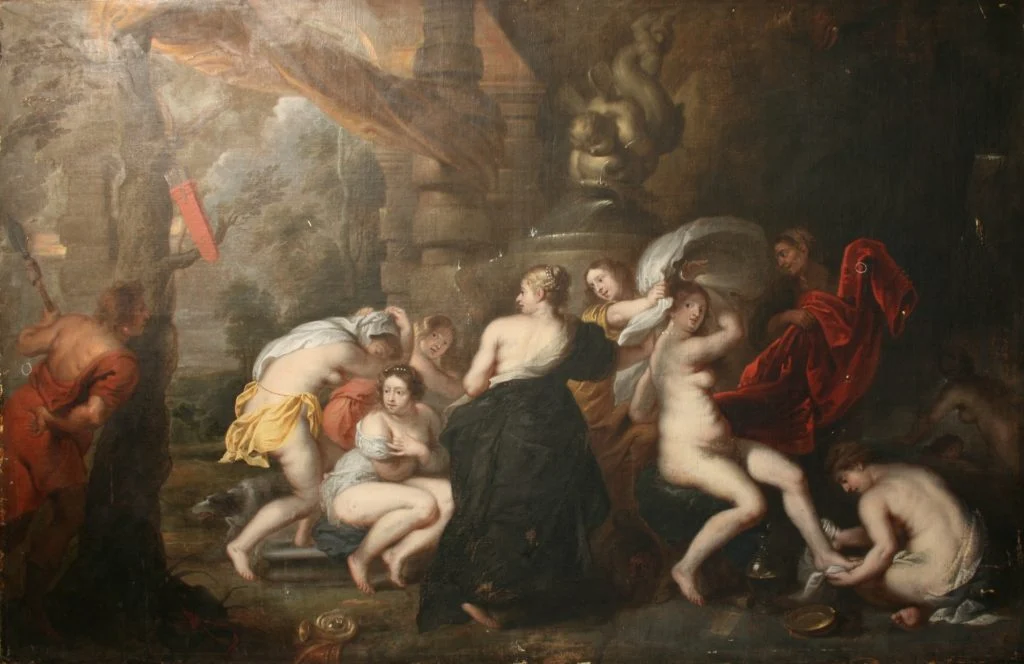As Artificial Intelligence Gains Ground in the Art World, Questions About Accuracy and Bias Persist
A fresh artificial intelligence (A.I.) analysis has once again thrust The Bath of Diana (circa 1635) into the spotlight—a painting long dismissed by experts as merely a copy of a lost work by Flemish Baroque master Peter Paul Rubens. A Swiss authentication firm now claims that parts of the painting may, in fact, bear Rubens’ distinctive touch, sparking renewed debate over the accuracy of A.I.-driven attribution and the challenges that come with integrating technology into the often subjective world of art authentication.
A.I. Analysis Reopens a Longstanding Debate
The Bath of Diana, depicting the Roman goddess Diana and her nymphs bathing before the tragic encounter with Actaeon, has been the subject of controversy for decades. Art historians widely regarded it as a later copy inspired by a lost original by Rubens. However, a cutting-edge A.I. analysis conducted by ArtRefine Analytics, a Swiss-based firm specializing in high-resolution imaging and neural network technology, suggests otherwise.
The firm’s algorithm, trained on thousands of verified Rubens works, identified subtle brushwork, color layering, and compositional details in specific areas of the painting that are consistent with Rubens’ known style. According to ArtRefine’s lead scientist, Dr. Lukas Meier, “Our system detected signature elements of Rubens’ technique in the treatment of light and texture, particularly in the rendering of flesh tones and drapery.”
Disputed Findings and Pushback from Scholars
Despite these findings, the A.I.-backed attribution has been met with skepticism by prominent Rubens experts, including Dr. Julius Held, a leading Rubens scholar, who has spent decades studying the artist’s body of work.
“While A.I. can be a valuable tool for analyzing patterns and styles, it is no substitute for the trained eye and historical context that human experts bring,” Held stated. “The nuances of Rubens’ hand go beyond technical signatures—his brushwork carries an emotional and narrative depth that machines cannot yet fully grasp.”
Dr. Held and other scholars argue that while A.I. can provide useful insights, it remains prone to confirmation bias if the algorithm is trained on incomplete or skewed datasets. Moreover, they caution that algorithms may not account for variations introduced by Rubens’ prolific studio, where assistants often contributed to large-scale works.
How Does A.I. Authentication Work?
A.I. authentication typically involves analyzing high-resolution scans of a painting and comparing them to extensive databases of known works by a particular artist. Algorithms assess a variety of factors, including:
- Brushstroke patterns
- Color and pigment distribution
- Layering and underpainting techniques
- Compositional symmetry and stylistic consistency
In theory, this process allows A.I. to detect patterns imperceptible to the human eye. However, A.I.-driven authentication is far from infallible, particularly when it comes to historical artworks that may have been retouched, restored, or partially completed by studio assistants.
The Potential and Pitfalls of A.I. in the Art Market
As A.I. technology becomes increasingly sophisticated, it is being integrated into authentication processes by auction houses, museums, and private collectors. The potential benefits include:
✅ Speed and Efficiency: A.I. can analyze a painting in a fraction of the time it takes human experts.
✅ Objective Pattern Recognition: Algorithms can identify consistent patterns that might escape the human eye.
✅ Enhanced Preservation Efforts: Identifying areas of potential degradation can assist in conservation planning.
However, the pitfalls are just as significant:
⚠️ Bias in Training Data: If A.I. models are trained on incomplete or flawed datasets, they can reinforce errors and lead to misattributions.
⚠️ Over-Reliance on Technology: The subjective and contextual aspects of art, such as an artist’s intention or variations introduced by a studio, can be overlooked.
⚠️ Legal and Ethical Concerns: Misattributions can have far-reaching financial and reputational consequences for collectors and institutions.
What’s Next for The Bath of Diana?
Following the A.I. analysis, the debate over The Bath of Diana is far from settled. ArtRefine Analytics is now advocating for a multidisciplinary approach that combines A.I. findings with traditional connoisseurship to reach a more nuanced conclusion.
Meanwhile, the painting is expected to be submitted for further physical analysis, including X-ray fluorescence (XRF) and pigment dating, which could provide additional clues about its origins.
As the art world grapples with the growing role of artificial intelligence, The Bath of Diana serves as a cautionary tale—reminding us that while A.I. may revolutionize art authentication, it is not yet a flawless oracle. For now, the question of Rubens’ hand in the work remains open to interpretation.



0 Comments